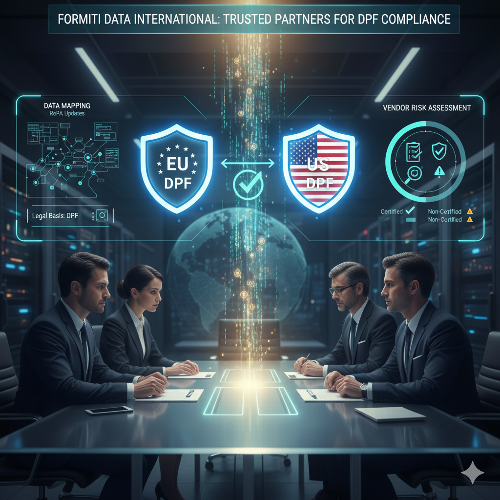DPF Decoded: How the EU-US Data Privacy Framework Impacts Your Data Mapping and Vendor Risk
The EU-US Data Privacy Framework (DPF) marks a critical turning point in transatlantic data transfers. After years of uncertainty following the invalidation of Privacy Shield, the DPF provides a much-needed, yet still scrutinized, mechanism for organizations to legally transfer personal data from the EU to the US.
For businesses, especially those engaging in extensive international data flows and relying on US-based vendors, understanding the DPF's nuances is paramount. This framework directly impacts your data mapping strategies, vendor risk assessments, and overall compliance posture.
Formiti Data International is here to demystify the complexities of the DPF, ensuring your organization can leverage this framework while maintaining robust data privacy and security.
?️ What is the EU-US Data Privacy Framework (DPF)?
The EU-US Data Privacy Framework is an adequacy decision adopted by the European Commission, allowing for the free flow of personal data from the European Union to certified US organizations without requiring additional safeguards like Standard Contractual Clauses (SCCs) or Binding Corporate Rules (BCRs). It aims to restore trust and legal certainty for transatlantic data transfers.
Key Components of the DPF:
- Certification Mechanism: US organizations self-certify their adherence to DPF Principles (similar to the former Privacy Shield). This includes commitments to data minimization, purpose limitation, data security, and individual rights.
- Strengthened US Safeguards: The DPF is underpinned by Executive Order 14086, which introduced new safeguards regarding US intelligence access to data (limiting it to "necessary and proportionate" levels) and established a multi-layer redress mechanism for EU individuals.
- Redress Mechanism: EU individuals now have access to a new Data Protection Review Court (DPRC) to investigate and resolve complaints regarding US intelligence agencies' access to their data.
?️ The DPF's Impact on Your Data Mapping
Data mapping is the foundational step in understanding where your organization collects, processes, stores, and transfers personal data. The DPF fundamentally alters how you view data transfers to the US.
1. Identifying Data Flows to the US:
- Primary Destination: Your data map must clearly identify all instances where personal data is transferred to the United States.
- Recipient Identification: Pinpoint the specific US entities receiving this data. This includes direct transfers to your own US subsidiaries and, critically, transfers to third-party vendors.
2. Legal Basis for Transfer:
- DPF as a Primary Mechanism: For transfers to certified US organizations, the DPF now serves as a primary legal basis, simplifying compliance compared to SCCs. Your data map should update the legal basis accordingly.
- Distinguishing Certified vs. Non-Certified: Your map needs to differentiate between US recipients certified under the DPF and those who are not.
- Certified: Transfers to these entities can rely on the DPF.
- Non-Certified: Transfers still require other mechanisms (e.g., SCCs, BCRs, derogations), often accompanied by Transfer Impact Assessments (TIAs).
3. Updating Records of Processing Activities (RoPA):
- Legal Basis Field: The DPF provides a new entry for the legal basis of transfer in your RoPA (under GDPR Article 30 requirements).
- Data Flow Diagrams: Visual representations of data flows should reflect the DPF as a legitimate pathway to the US.
4. Reduced Need for TIAs for Certified Entities:
- Streamlined Assessment: Transfers based on the DPF generally do not require a separate Transfer Impact Assessment (TIA) for the specific transfer, as the European Commission's adequacy decision already validates the US legal framework's safeguards for DPF-certified entities.
- Still Critical for SCCs: If you continue to use SCCs for non-certified US vendors, TIAs remain a crucial requirement.
Vendors ? Vendor Risk Management Under the DPF
The DPF significantly streamlines the process of assessing and onboarding US-based data processors, but it doesn't eliminate due diligence.
1. DPF Certification as a Key Vetting Criterion:
- Primary Filter: When evaluating US vendors, DPF certification should now be a primary criterion. Prioritize vendors who have successfully self-certified.
- Verification: Always verify a vendor's DPF status on the official Data Privacy Framework List website (www.dataprivacyframework.gov). Do not just rely on their self-declaration.
2. Updating Data Processing Agreements (DPAs):
- Reference DPF: Your DPAs with certified US vendors should now explicitly reference the DPF as the legal basis for international data transfers, rather than just SCCs.
- SCCs as a Fallback/Alternative: For US vendors not certified under the DPF, or as a robust fallback, SCCs will still be necessary. Your DPA should clearly outline the applicable transfer mechanism.
3. Ongoing Monitoring of DPF Status:
- Annual Re-certification: DPF certification requires annual re-certification. Your vendor risk management program must include a process to monitor and verify your US vendors' ongoing DPF status.
- Notification Clauses: Ensure your DPAs require US vendors to notify you immediately if their DPF certification lapses or is revoked.
4. Refined Risk Assessment for Non-Certified Vendors:
- Elevated Scrutiny: For US vendors who are not DPF-certified, your vendor risk assessments will need to apply even greater scrutiny.
- Enhanced TIAs: For these vendors, conducting thorough Transfer Impact Assessments (TIAs) becomes even more critical to justify the use of SCCs or other transfer mechanisms.
❓ Frequently Asked Questions (Q&A)
Q: Does the DPF mean I can stop using SCCs for all US transfers? A: No. You can stop using SCCs only for transfers to US organizations that are actively certified under the DPF. For any US entity that is not DPF-certified, you will still need to rely on SCCs (and likely a TIA) or another appropriate transfer mechanism.
Q: Where can I check if a US company is DPF certified? A: You must check the official Data Privacy Framework List website: www.dataprivacyframework.gov. This is the authoritative source for verifying certification.
Q: Is the DPF "Schrems III" proof? A: The DPF has been designed to address the concerns raised in the Schrems II ruling, particularly regarding US intelligence access and redress mechanisms. However, Max Schrems and his organization Noyb have already indicated plans to challenge the DPF. While it offers immediate legal certainty, its long-term future may still face judicial scrutiny. Organizations should remain vigilant and prepare for potential future developments.
Q: Does the DPF apply to data transferred from the UK or Switzerland? A: Not directly. The EU-US DPF covers transfers from the EU. The UK and Switzerland are working on their own respective frameworks (UK-US Data Bridge, Swiss-US DPF) which are closely aligned but separate.
Partner with Formiti Data International to transform DPF compliance from a challenge into a strategic advantage, ensuring your data transfers are legal, secure, and resilient. click here to request more information

